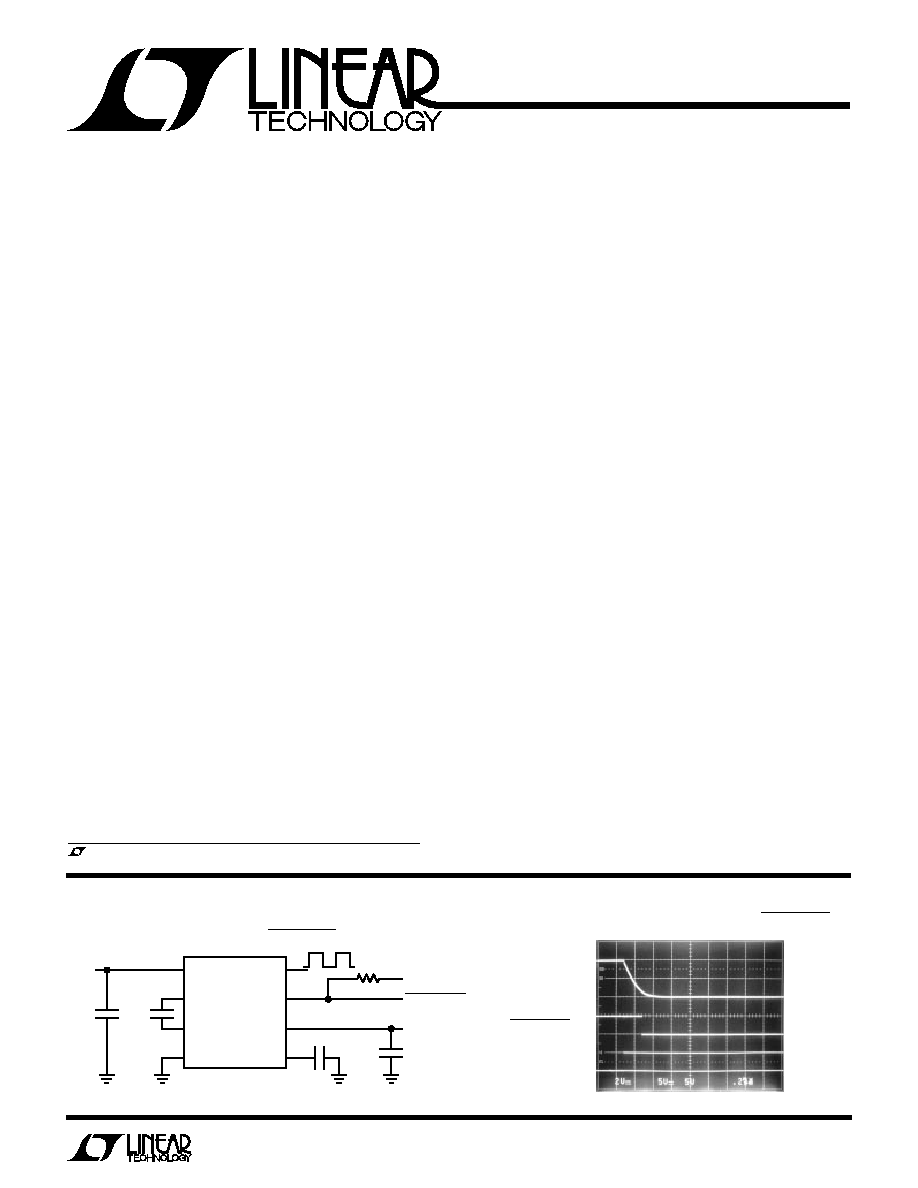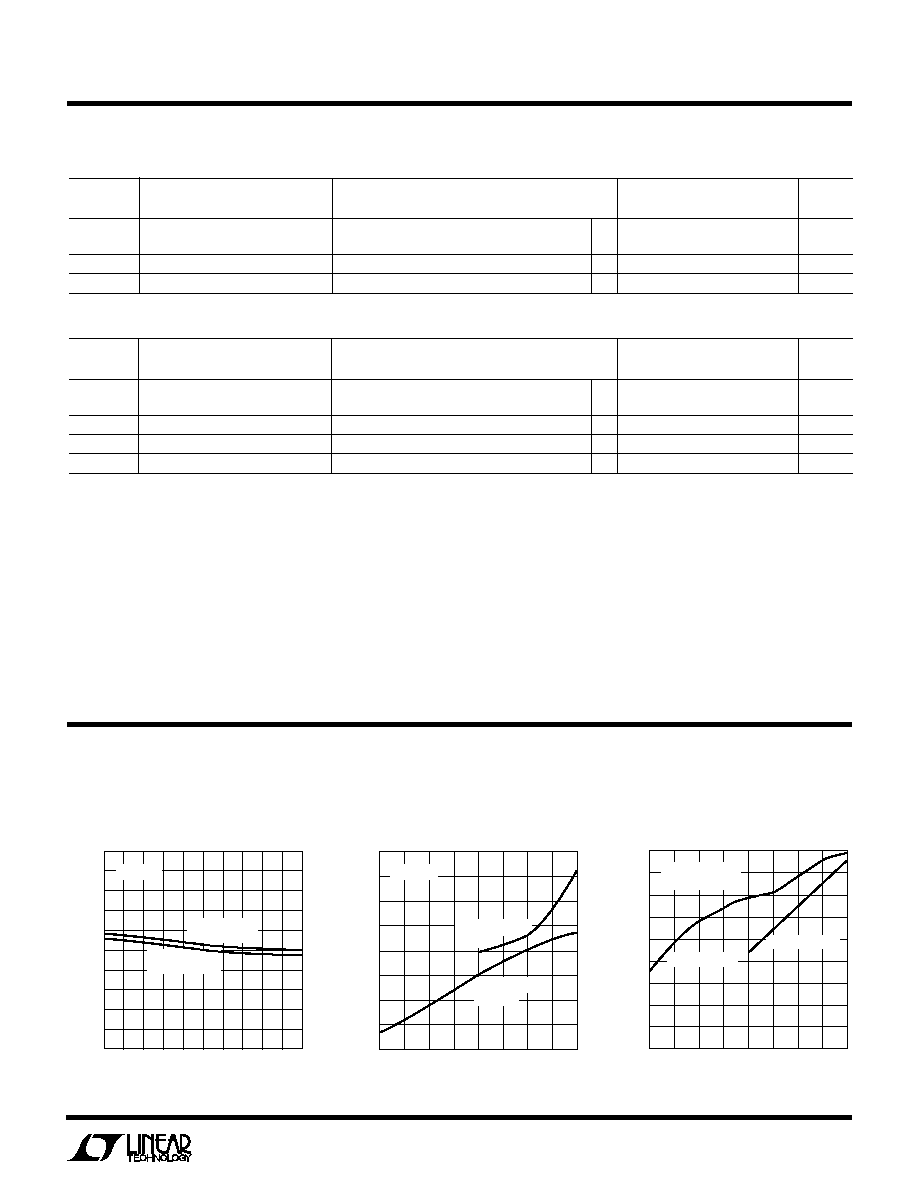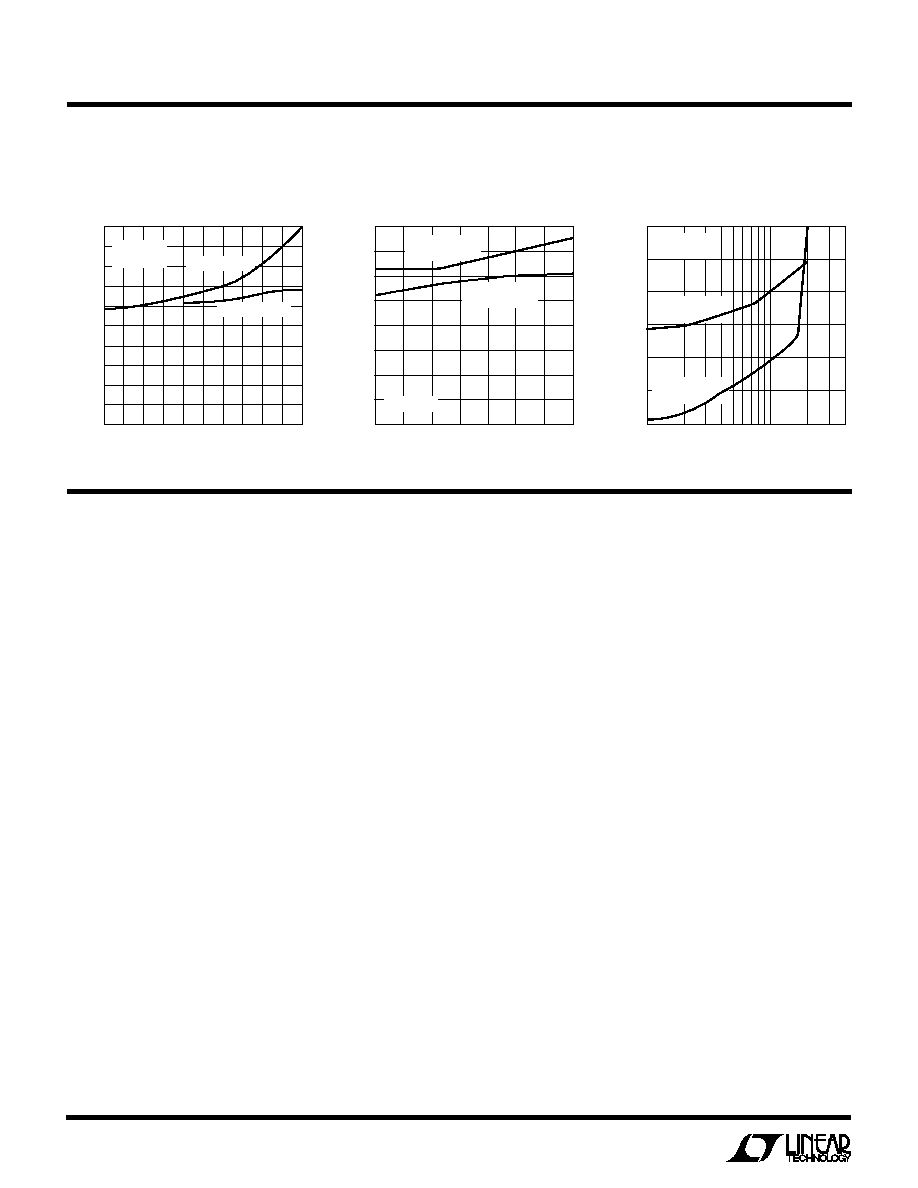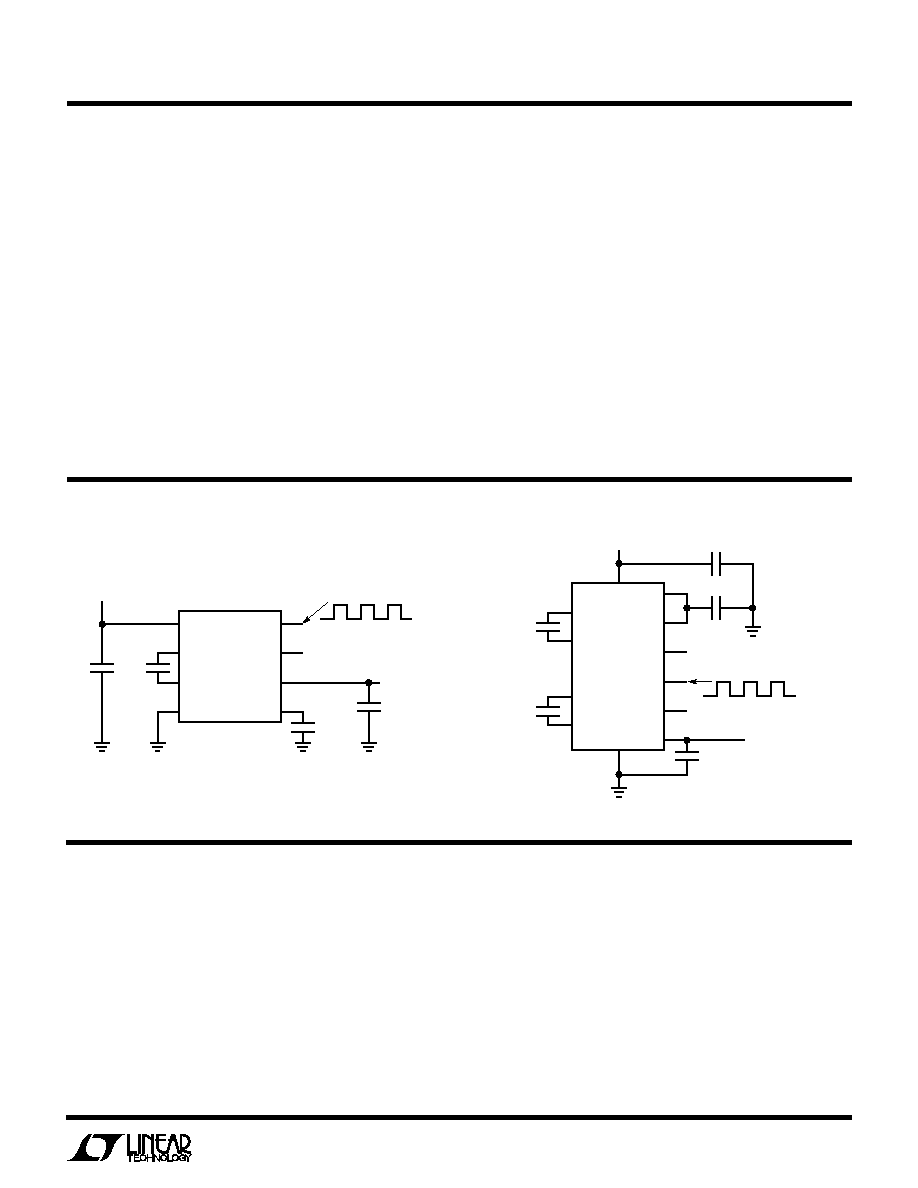 | ÐлекÑÑоннÑй компоненÑ: LTC1429CS | СкаÑаÑÑ:  PDF PDF  ZIP ZIP |
Äîêóìåíòàöèÿ è îïèñàíèÿ www.docs.chipfind.ru

1
LTC1429
s
Regulated Negative Voltage from a Single
Positive Supply
s
External Clock for Synchronization in Noise
Sensitive Systems
s
REG Output Indicates Output is in Regulation
s
Low Output Ripple: 5mV Typ
s
Can Provide Regulated 5V from a 3V Supply
s
Supply Current: 600
µ
A Typ
s
Shutdown Mode Drops Supply Current to 0.2
µ
A
s
Up to 12mA Output Current
s
Adjustable or Fixed Output Voltages
s
Requires Only Three or Four External Caps
s
Output Regulation: 5%
s
Available in SO-8 Packages
The LTC
®
1429 is a switched-capacitor voltage inverter de-
signed to provide a regulated negative voltage from a single
positive supply and permits clock synchronization in noise
sensitive systems. The LTC1429CS operates from a single 3V
to 8V supply and provides an adjustable output voltage from
1.25V to 8V. An on-chip resistor string allows the
LTC1429CS to be configured for output voltages of 3.5V,
4V, 4.5V or 5V. The LTC1429CS8 is optimized for
applications which require a fixed 4V output from a 5V
supply and requires only a single external 0.1
µ
F flying
capacitor. The LTC1429CS requires one or two external
0.1
µ
F capacitors, depending on input voltage. Both versions
require additional external input and output bypass capaci-
tors. An optional compensation capacitor at ADJ/COMP can
be used to reduce the output voltage ripple.
Each version of the LTC1429 guarantees output regulation of
5%. The LTC1429 includes an open-drain REG output which
pulls low when the output is within 5% of the set value. Output
ripple is typically as low as 5mV. The LTC1429 requires an
external clock applied to the SYNC/SD for normal operation
and consumes a typical quiescent current of 600
µ
A. Holding
the SYNC/SD either high or low brings the device into
shutdown and the supply current drops to 0.2
µ
A. For appli-
cations which don't have a clock signal available, the LTC1261
provides the same functionality with an internal oscillator. For
applications which require output ripple below 1mV, see the
LTC1550/LTC1551. The LTC1429CS is available in a 14-pin
SO package and the LTC1429CS8 is available in an 8-pin SO
package.
Clock-Synchronized
Switched Capacitor
Regulated Voltage Inverter
FEATURES
DESCRIPTIO
N
U
s
GaAs FET Bias Generators
s
Negative Supply Generators
s
Battery Powered Systems
s
Single Supply Applications
APPLICATIO
N
S
U
TYPICAL APPLICATIO
N
U
4V Generator with Power Valid
, LTC and LT are registered trademarks of Linear Technology Corporation.
1
2
3
4
8
7
6
5
C2
0.1
µ
F
C1
0.1
µ
F
*C3
0.001
µ
F
V
OUT
= 4V AT 10mA
POWER VALID
5V
5V
C4
3.3
µ
F
V
CC
GND
C1
+
C1
SYNC/SD
COMP
REG
OUT
LTC1429-4CS8
+
10k
LTC1429 · TA01
*OPTIONAL
0.2ms/DIV
0V
5V
SYNC/SD
0V
5V
POWER VALID
4V
0V
V
OUT
Waveforms for 4V Generator with Power Valid
LTC1429 · TA02

2
LTC1429
LTC1429CS8/LTC1429CS
SYMBOL
PARAMETER
CONDITIONS
MIN
TYP
MAX
UNITS
V
REF
Reference Voltage
q
1.20
1.24
1.28
V
I
S
Supply Current
V
CC
= 3.3V
q
600
1500
µ
A
V
CC
= 5V
q
600
1500
µ
A
V
SYNC/SD
= V
CC
or GND
q
0.2
5
µ
A
F
SYNC
Synchronous Clock Frequency (Note 8)
V
CC
5V
60
700
2000
kHz
V
CC
= 6.5V
100
700
2000
kHz
P
EFF
Power Efficiency
65
%
V
OL
REG Output Low Voltage
I
REG
= 1mA
q
0.1
0.8
V
I
REG
REG Sink Current
V
REG
= 0.8V, V
CC
= 3.3V
q
5
8
mA
V
REG
= 0.8V, V
CC
= 5V
q
8
15
mA
I
ADJ
Adjust Pin Current
V
ADJ
= 1.24V (Note 5)
q
0.01
1
µ
A
V
IH
SYNC/SD Input High Voltage
V
CC
= 5V
q
2.0
V
V
IL
SYNC/SD Input Low Voltage
V
CC
= 5V
q
0.8
V
I
IN
SYNC/SD Input Current
V
SYNC/SD
= V
CC
or GND
q
±
1
µ
A
T
ON
Turn On Time
I
OUT
= 10mA
200
µ
s
ABSOLUTE
M
AXI
M
U
M
RATINGS
W
W
W
U
PACKAGE/ORDER I
N
FOR
M
ATIO
N
W
U
U
LTC1429CS8-4*
ORDER PART
NUMBER
LTC1429CS
ORDER PART
NUMBER
T
JMAX
= 150
°
C,
JA
= 150
°
C/ W
S8 PART MARKING
Consult factory for Industrial and Military grade parts. *Contact factory for other output voltages or 8-pin adjustable parts.
V
CC
= 3V to 6.5V. C1 = C2 = 0.1
µ
F (Note 4), C
OUT
= 3.3
µ
F, F
SYNC
= 700kHz with 50% duty cycle square wave, unless otherwise noted.
(Note 1)
Supply Voltage (Note 2)............................................. 9V
Output Voltage .............................................0.3V to 9V
Total Voltage, V
CC
to V
OUT
(Note 2) ......................... 12V
Input Voltage (SYNC/SD Pin) ...... 0.3V to (V
CC
+ 0.3V)
Input Voltage (REG Pin)............................. 0.3V to 12V
Input Voltage (ADJ, RO-1, R
ADJ
)
.....................................(V
OUT
0.3V) to (V
CC
+ 0.3V)
Output Short Circuit Duration .......................... Indefinite
Operating Temperature Range ..................... 0
°
C to 70
°
C
Storage Temperature Range ................. 65
°
C to 150
°
C
Lead Temperature (Soldering, 10 sec) .................. 300
°
C
14294
ELECTRICAL CHARACTERISTICS
1
2
3
4
8
7
6
5
TOP VIEW
SYNC/SD
REG
OUT
COMP
V
CC
C1
+
C1
GND
S8 PACKAGE
8-LEAD PLASTIC SO
T
JMAX
= 150
°
C,
JA
= 110
°
C/ W
TOP VIEW
S PACKAGE
14-LEAD PLASTIC SO
1
2
3
4
5
6
7
14
13
12
11
10
9
8
NC
C1
+
C1
C2
+
C2
GND
R0
V
CC
SYNC/SD
REG
OUT
ADJ
R
ADJ
R1

3
LTC1429
ELECTRICAL CHARACTERISTICS
The
q
denotes specifications which apply over the full operating
temperature range.
Note 1: Absolute Maximum Ratings are those values beyond which the life
of the device may be impaired.
Note 2: Setting output to < 7V will exceed the total voltage maximum
rating with a 5V supply. With supplies higher than 4V the output should
never be set to exceed (V
CC
12V).
Note 3: All currents into device pins are positive; all currents out of device
pins are negative. All voltages are referenced to ground, unless otherwise
specified. All typicals are given at T
A
= 25
°
C.
Note 4: C1 = C2 = 0.1
µ
F means the specifications apply to tripler mode
where V
CC
V
OUT
= 3.3V
CC
(LTC1429CS only; the LTC1429CS8 cannot be
connected in tripler mode), with C1 connected between C1
+
and C1
and
C2 connected between C2
+
and C2
. C2 = 0 implies doubler mode where
V
CC
V
OUT
= 2V
CC
; for the LTC1429CS, this means C1 connects from C1
+
to C2
with C1
and C2
+
floating. For the LTC1429CS8 in doubler mode,
C1 connects from C1
+
to C1
; there are no C2 pins.
Note 5: Adjustable output parts only; does not apply to fixed output parts.
Note 6: For output voltages below 4.5V, the LTC1429 may reach 50%
duty cycle and fall out of regulation with heavy load or low input voltages.
Beyond this point, the output will follow the input with no regulation.
Note 7: LTC1429 will operate with square wave of 40% to 60% duty cycle.
For best performance, use a square wave with 50% duty cycle.
Note 8: Maximum frequency is not tested. Typical part can be used
beyond 2MHz.
LTC1429CS
SYMBOL
PARAMETER
CONDITIONS
MIN
TYP
MAX
UNITS
V
OUT
Output Regulation
1.24V
V
OUT
4V, 0
I
OUT
12mA
q
1
5
%
4V
V
OUT
5V, 0
I
OUT
8mA
q
2
5
%
I
SC
Output Short Circuit Current
V
OUT
= 0V
q
35
75
mA
V
RIP
Output Ripple Voltage
I
OUT
= 5mA, V
OUT
= 4V
5
mV
Doubler Mode, V
CC
= 5V, C1 = 0.1
µ
F, C2 = 0 (Note 4), C
OUT
= 3.3
µ
F, F
SYNC
=700kHz with 50% duty cycle, unless otherwise noted.
LTC1429CS8/LTC1429CS
SYMBOL
PARAMETER
CONDITIONS
MIN
TYP
MAX
UNITS
V
OUT
Output Regulation
1.24V
V
OUT
4V, 0
I
OUT
10mA
q
1
5
%
4V
V
OUT
4.5V, 0
I
OUT
10mA (Note 6)
q
2
5
%
V
OUT
Output Voltage
V
OUT
Set to 4V, 0
I
OUT
10mA
q
3.80
4.00
4.20
V
I
SC
Output Short Circuit Current
V
OUT
= 0V
q
80
125
mA
V
RIP
Output Ripple Voltage
I
OUT
= 5mA, V
OUT
= 4V
10
mV
Tripler Mode,V
CC
= 3.3V, C1 = C2 = 0.1
µ
F (Note 4), C
OUT
= 3.3
µ
F,
F
SYNC
= 700kHz with 50% duty cycle square wave, unless otherwise noted.
Maximum Output Current vs
Supply Voltage
TYPICAL PERFOR
M
A
N
CE CHARACTERISTICS
U
W
Output Voltage vs Output Current
Output Voltage vs Supply Voltage
OUTPUT CURRENT (mA)
0
OUTPUT VOLTAGE (V)
4.02
4.06
4.10
4.08
4.04
4.00
3.96
3.92
8
LTC1429 · TPC01
3.98
3.94
3.90
2
1
3
5
7
9
4
6
10
T
A
= 25
°
C
V
CC
= 3.3V
TRIPLER MODE
V
CC
= 5V
DOUBLER MODE
SUPPLY VOLTAGE (V)
3.0
OUTPUT VOLTAGE (V)
4.04
4.05
4.06
7.0
LTC1429 · TPC02
4.03
4.02
4.00
4.0
5.0
6.0
4.01
4.08
4.07
3.5
4.5
5.5
6.5
DOUBLER MODE
I
L
= 5mA
TRIPLER MODE
I
L
= 5mA
T
A
= 25
°
C
SUPPLY VOLTAGE (V)
3.0
0
MAXIMUM OUTPUT CURRENT (mA)
5
15
20
25
6.5
6.0
45
LTC1429 · TPC03
10
3.5
4.0
4.5
5.0
5.5
7.0
30
35
40
V
OUT
= 4V
±
5%
T
A
= 25
°
C
TRIPLER MODE
DOUBLER MODE
(See Test Circuits; Figure 1 for Doubler Mode, Figure 2 for Tripler Mode)

4
LTC1429
TYPICAL PERFOR
M
A
N
CE CHARACTERISTICS
U
W
(See Test Circuits: Figure 1 for Doubler Mode, Figure 2 for Tripler Mode)
Supply Current vs Supply Voltage
Supply Current vs Temperature
TEMPERATURE (°C)
0
SUPPLY CURRENT (
µ
A)
700
30
LTC1429 · TPC05
400
200
10
20
40
100
0
800
600
500
300
50
60
70
V
CC
= 5V
DOUBLER MODE
V
CC
= 3.3V
TRIPLER MODE
V
OUT
= 4V
SUPPLY VOLTAGE (V)
3.0
SUPPLY CURRENT (
µ
A)
600
800
1000
900
700
500
300
100
7.0
LTC1429 · TPC04
400
200
0
4.0
3.5
4.5
5.5
6.5
7.5
5.0
6.0
8.0
V
OUT
= 4V
T
A
= 25
°
C
TRIPLER MODE
DOUBLER MODE
PI
N
FU
N
CTIO
N
S
U
U
U
Pin numbers are shown as (LTC1429CS/LTC1429CS8).
NC (Pin 1/NA): No Internal Connection.
C1
+
(Pin 2/Pin 2): C1 Positive Input. Connect an 0.1
µ
F
capacitor between C1
+
and C1
. With the LTC1429CS in
doubler mode, connect a 0.1
µ
F capacitor from C1
+
to C2
.
C1
(Pin 3/Pin 3): C1 Negative Input. Connect a 0.1
µ
F
capacitor from C1
+
to C1
. With the LTC1429CS in doubler
mode only, C1
should float.
C2
+
(Pin 4/NA): C2 Positive Input. In tripler mode, connect
a 0.1
µ
F capacitor from C2
+
to C2
. This pin is used with
the LTC1429CS in tripler mode only; in doubler mode, this
pin should float.
C2
(Pin 5/NA): C2 Negative Input. In tripler mode, con-
nect a 0.1
µ
F capacitor from C2
+
to C2
. In doubler mode,
connect a 0.1
µ
F capacitor from C1
+
to C2
.
GND (Pin 6/Pin 4): Ground. Connect to a low-impedance
ground. A ground plane will help to minimize regulation
errors.
R0 (Pin 7/NA): Internal Resistor String-1st Tap. See Table
3 in the Applications Information section for information
on internal resistor string pin connections vs output
voltage.
R1 (Pin 8/NA): Internal Resistor String-2nd Tap.
R
ADJ
(Pin 9/NA): Internal Resistor String Output. Connect
this pin to ADJ to use the internal resistor divider. See
Table 3 in the Applications Information section for infor-
mation on internal resistor string pin connections vs
output voltage.
ADJ (COMP for fixed output versions) (Pin 10/Pin 5):
Output Adjust/Compensation. For adjustable parts, this
pin is used to set the output voltage. The output voltage
should be divided down with a resistor divider and fed
back to this pin to set the regulated output voltage. The
resistor divider can be external or the internal divider
string can be used if it can provide the required output
voltage. Typically the resistor string should draw
10
µ
A
from the output to minimize errors due to the bias current
at the adjust pin. Fixed output parts have the internal
resistor string connected to this pin inside the package;
the pin can be used to trim the output voltage if desired. It
can also be used as an optional feedback compensation
pin to reduce output ripple on both adjustable and fixed
output voltage parts. See the Applications Information
section for more on compensation and output ripple.
OUT (Pin 11/Pin 6): Negative Voltage Output. This pin
must be bypassed to ground with a 1.0
µ
F or larger
capacitor; it must be at least 3.3
µ
F to provide specified
output ripple. The size of the output capacitor has a strong
INPUT FREQUENCY (kHz)
100
SUPPLY CURRENT (
µ
A)
750
700
650
600
550
500
450
1000
2000
4000
LTC1429 · TPC06
T
A
= 25
°
C
I
LOAD
= 0mA
DOUBLER MODE
V
CC
= 5V
TRIPLER MODE
V
CC
= 3.3V
Supply Current vs
Input Frequency

5
LTC1429
PI
N
FU
N
CTIO
N
S
U
U
U
pump to operate erratically or the device to shut down. A
logic high or low at the SYNC/SD pin will put the device
into SHUTDOWN and drop the supply current to 0.2
µ
A.
The LTC1429 will operate with input square wave of 40%
to 60% duty cycle. For best performance, use a square
wave of 50% duty cycle.
V
CC
(Pin 14/Pin 1): Power Supply. This requires an input
voltage between 3V and 6.5V. Certain combinations of
output voltage and operating mode may place additional
restrictions on the input voltage; see the Applications
Information section for details. V
CC
must be bypassed to
ground with at least a 0.1
µ
F capacitor, placed in close
proximity to the chip; again, see the Applications Informa-
tion section.
TEST CIRCUITS
Figure 2. Tripler Mode
effect on output ripple; see the Applications Information
section for more details.
REG (Pin 12/Pin 7): This is an open drain output that pulls
low when the output voltage is within 5% of the set value.
It will sink 10mA to ground with a 5V supply. The external
circuitry must provide a pull-up or REG will not swing high.
The voltage at REG may exceed V
CC
; it can be pulled up to
12V above ground without damage.
SYNC/SD (Pin 13/Pin 8): Synchronous Clock Input. A
minimum input clock frequency (60kHz with V
CC
5V and
100kHz with V
CC
= 6.5V) must be applied to this input to
keep the LTC1429 operating normally. An input clock
below the minimum frequency may cause the charge
Figure 1. Doubler Mode
1
2
3
4
8
7
6
5
0.1
µ
F
10
µ
F
0.001
µ
F
V
OUT
= 4V
±
5%
5V
3.3
µ
F
V
CC
GND
C1
+
C1
SYNC/SD
COMP
REG
OUT
LTC1429-4CS8
+
LTC1429 · TC01
F
SYNC
= 700kHz
APPLICATIO
N
S I
N
FOR
M
ATIO
N
W
U
U
U
MODES OF OPERATION
The LTC1429 uses a charge pump to generate a negative
output voltage that can be regulated to a value either
higher or lower than the original input voltage. It has two
modes of operation: a doubler inverting mode, which can
provide a negative output equal to or less than the positive
power supply, and a tripler inverting mode, which can
provide negative output voltages either larger or smaller in
magnitude than the original positive supply. The tripler
offers greater versatility and wider input range but re-
quires four external capacitors and a 14-pin package; the
doubler offers the SO-8 package and requires only three
external capacitors. The optional compensation capacitor
at ADJ/COMP is used to reduce the ripple output voltage.
Doubler Mode
This mode allows the LTC1429 to generate negative
output voltage magnitudes up to that of the supply voltage,
10
9
8
13
7
11
0.001
µ
F
V
OUT
= 4V
±
5%
3.3
µ
F
LTC1429 · TC02
F
SYNC
= 700kHz
NC
NC
10
µ
F
+
V
IN
= 3.3V
V
CC
GND
ADJ
SYNC/SD
R0
OUT
R
ADJ
R1
LTC1429CS
14
6
+
2
3
4
5
C1
+
C1
C2
+
C2
0.1
µ
F
0.1
µ
F




